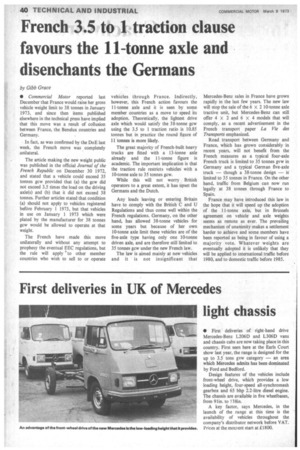French 3.5 to 1 traction clause favours the 11-tonne axle and disenchants the Germans
Page 42

If you've noticed an error in this article please click here to report it so we can fix it.
by Gibb Grace • Commercial Motor reported last December that France would raise her gross vehicle weight limit to 38 tonnes in January 1973, and since then items published elsewhere in the technical press have implied that this move was a result of collusion between France, the Benelux countries and Germany.
In fact, as was confirmed by the DoE last week, the French move was completely unilateral.
The article making the new weight public was published in the official Journal of the French Republic on December 30 1972, and stated that a vehicle could exceed 35 tonnes gcw provided that (a) the gcw did not exceed 3.5 times the load on the driving axle(s) and (b) that it did not exceed 38 tonnes. Further articles stated that condition (a) should not apply to vehicles registered before February 1 1973, but that vehicles in use on January 1 1973 which were plated by the manufacturer for 38 tonnes gcw would be allowed to operate at that weight.
The French have . made this move unilaterally and without any attempt to prophesy the eventual EEC regulations, but the rule will apply tto other member countries who wish to sell to or operate vehicles through France. Indirectly, however, this French action favours the 11-tonne axle and it is seen by some member countries as a move to speed its adoption. Theoretically, the lightest drive axle which would satisfy the 38-tonne gcw using the 3.5 to 1 traction ratio is 10.85 tonnes but in practice the round figure of 11 tonnes is more likely.
The great majority of French-built heavy trucks are fitted with a 13-tonne axle already and the 11-tonne figure is academic. The important implication is that the traction rule restricts vehicles with a 10-tonne axle to 35 tonnes gcw.
While this will not worry British operators to a great extent, it has upset the Germans and the Dutch.
Any loads leaving or entering Britain have to comply with the British C and U Regulations and thus come well within the French regulations. Germany, on the other hand, has allowed 38-tonne vehicles for some years but because of her own 10-tonne axle limit these vehicles are of the five-axle type having only one 10-tonne driven axle, and are therefore still limited to 35 tonnes gcw under the new French law.
The law is aimed mainly at new vehicles and it is not insignificant that
Mercedes-Benz sales in France have grown rapidly in the last few years. The new law will stop the sale of the 6 x 2 10-tonne axle tractive unit, but Mercedes-Benz can still offer 4 X 2 and 6 X 4 models that will comply, as a recent advertisement in the French transport paper La Vie des Transports emphasized.
Road transport between Germany and France, which has grown considerably in recent years, will not benefit from the French measures as a typical four-axle French truck is limited to 35 tonnes gvw in Germany and a typical German five-axle truck — though a 38-tonne design — is limited to 35 tonnes in France. On the other hand, traffic from Belgium can now run legally at 38 tonnes through France to Spain.
France may have introduced this law in the hope that it will speed up the adoption of the 11-tonne axle, but in Brussels agreement on vehicle and axle weights seems as remote as ever. The prevailing mechanism of unanimity makes a settlement harder to achieve and some members have been reported as being in favour of using a majority vote. Whatever weights are eventually adopted it is unlikely that they will be applied to international traffic before 1980, and to domestic traffic before 1985.




















































































































































